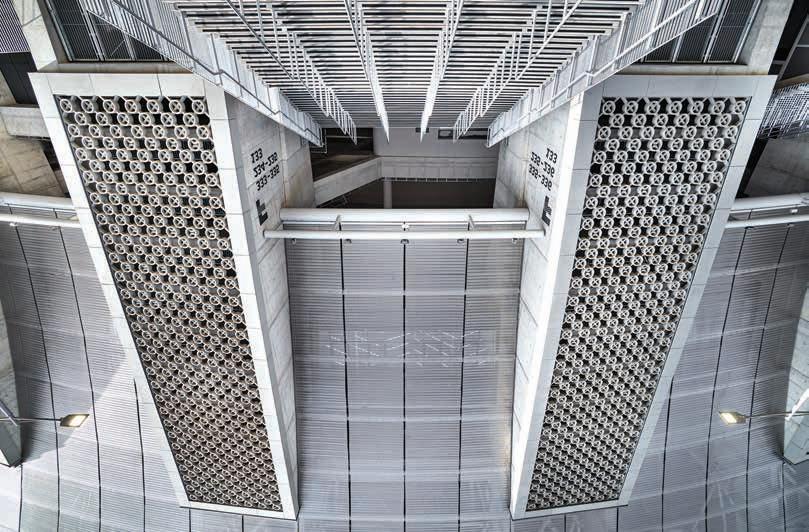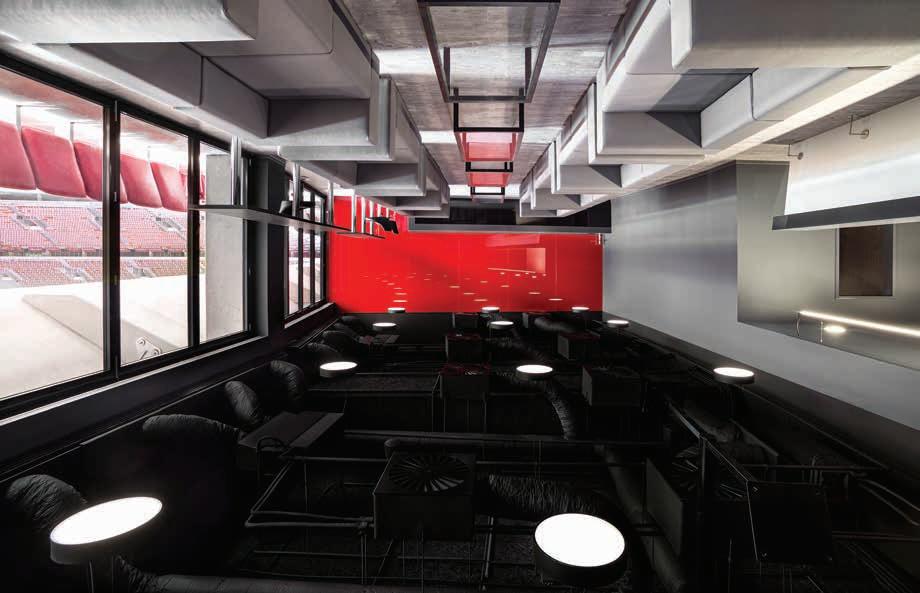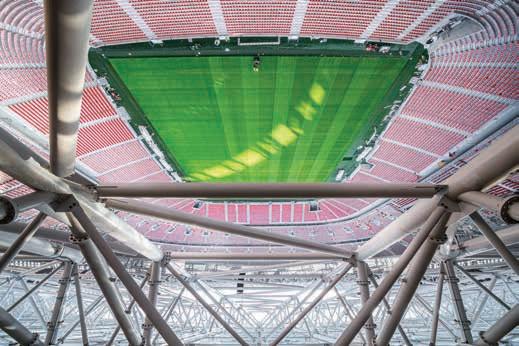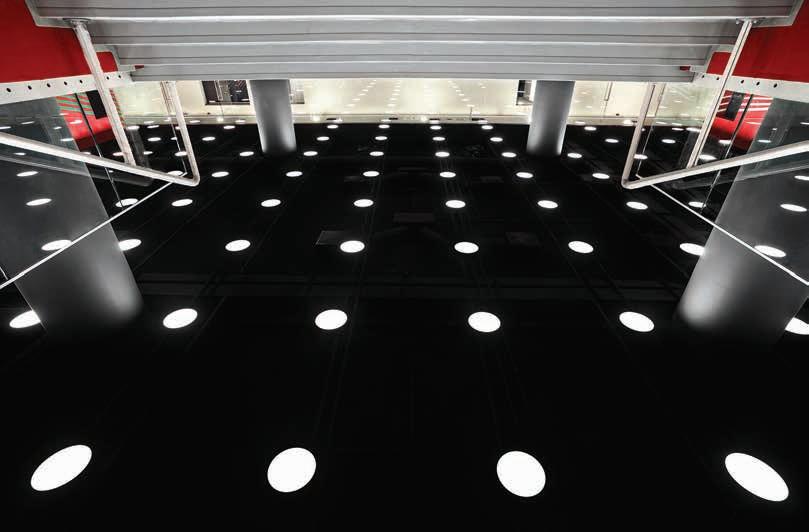
5 minute read
Budapešťskou Puskás Arénu osvětlí česká svítidla

Budapešťskou Puskás Arénu osvětlí česká svítidla The Puskás Arena in Budapest will be lit with Czech lights
Advertisement
Evropa má po dvou letech přestavby Puskás Arény nové moderní. místo pro pořádání sportovních a kulturních akcí..
Fotbalový stadion Maďarské fotbalové federace s kapacitou více než 67 000 křesel splňuje všechny požadavky UEFA a FIFA. Proto bude letos jedním 12 evropských stadionů, který bude hostit UEFA EURO 2020. Puskás Arena byla slavnostně otevřena loni v listopadu mezistátním zápasem Maďarsko – Uruguay. Hlavním architektem projektu byl György Skardelli z architektonického studia KÖZTI Architects & Engineers. O osvětlení interiéru se postaral český výrobce svítidel, společnost Halla.
STADION S PĚTI HVĚZDIČKAMI Puskás Aréna stojí na místě původního stadionu Ference Puskáse, jehož demolice uskutečnila v roce 2016. Výstavba nové arény byla financována maďarskou vládou a stála 610 mil. eur; jde tedy o jeden z nejdražších stadionů v Evropě – pouze dva ruské a tři anglické stadiony stály více. Aréna pravděpodobně získá také pětihvězdičkový status od UEFA a FIFA, což znamená, že eventuálně bude možné zde pořádat hlavní evropské finále.
Původní návrh zahrnoval vyvýšenou běžeckou dráhu, která nabízela panoramatický výhled na město. Zároveň byl stadion navržen tak, aby poskytoval zázemí i pro další druhy sportu. V době výstavby byl však projekt změněn a stadion je nyní uzpůsoben k pořádání fotbalových utkání a kulturních akcí. V budově, která je s 52 m druhou nejvyšší ve městě, se nacházejí také konferenční místnosti, restaurace a muzeum. Kromě toho jsou hostům k dispozici VIP prostory a 84 skyboxů.
INTERIÉRU DOMINUJÍ ČESKÁ SVÍTIDLA Puskás Arénu charakterizují dva výrazné prvky – zvenčí jde o betonovou kulatou mozaiku, v interiéru sehrálo významnou úlohu osvětlení. O to se z velké části zasloužila česká společnost Halla. „Nabídli dobrou kvalitu za rozumnou cenu, což pro nás bylo velmi důležité, neboť jen k vytvoření vzoru rybích kostí jsme použili asi 7 km lineárních svítidel. Velkou předností byla též jejich snadná montáž,“ komentoval výběr dodavatele István Vonnak z West Hungaria Bau. Zmíněný systém lineárních svítidel ve vzoru rybí kosti dominuje VIP patru.
Produkty Halla byly použity i v dalších částech arény tak, aby podtrhly dynamiku interiéru. Celkem 1 800 kruhových svítidel bylo umístěno ve skyboxech a salonech ve VIP zóně, ve foyer v přízemí a v hale, kde hráči vstupují na hřiště. „Máme velkou radost, že se nám na dřívější realizace v Maďarsku podařilo navázat takto prestižní a velkou realizací. Architekti si dali na návrhu opravdu záležet a za to jim patří velký dík,“ uvedl Daniel Černý, předseda představenstva společnosti Halla, která exportuje do desítek zemí na celém světě.
RED
After two years of reconstruction for the. Puskás Arena, Europe has a new modern. place for sports and cultural events..



The football stadium of the Hungarian Football Federation, with a capacity of over 67,000 seats, meets all UEFA and FIFA requirements. That is why it will, this year, become one
of the 12 European stadiums that are to host the UEFA EURO 2020. Puskás Arena was inaugurated last November by an international match between Hungary and Uruguay. The senior architect of the project was György Skardelli from the architectural studio KÖZTI Architects & Engineers. The interior lighting was taken care of by the Czech light producer, Halla.




A FIVE-STAR STADIUM Puskás Arena is situated in a place of the former Ferenc Puskás Stadium which demolition took place in 2016. Construction of the new arena was financed by the Hungarian government and cost EUR 610 million; that makes it one of the most expensive stadiums in Europe – only two Russian and three English stadiums cost more. The arena is, most probably, to also receive five-star status from UEFA and FIFA, which means that it will also be possible to organize the European final there.
The original project also included an elevated running track, which offered panoramic views of the city. The stadium was also designed in such a way as to provide background facilities for other types of sports. But the project was altered during construction and the stadium is now adjusted for both football matches and cultural events. The building, which is, with its 52 m, also the second highest building in the city, also includes conference rooms, restaurants and a museum. Apart from that, guests are also provided with VIP premises and 84 skyboxes.

THE INTERIOR IS DOMINATED BY CZECH LIGHTS Puskás Arena is characteristic for two significant features – on the outside, it is a concrete rounded mosaic, whilst on the inside, a significant role was taken by lighting. This is mostly due to the Czech company Halla. “They offered excellent quality at a reasonable price, which was very important to us, as we used approximately 7 km of linear lights just for the creation of a fishbone shape. Their easy installation was also advantageous,” said István Vonnak from West Hungaria Bau about the choice of the supplier. The aforementioned system of linear lights in the shape of a fishbone dominates the VIP storey.
Halla’s products were also used in other parts of the arena in order to highlight the dynamics of the interior. A total of 1,800 round lights were installed in skyboxes and salons in the VIP zone, the foyer on the ground floor and in the hall from where the players enter the pitch. “We are really pleased that we have managed to follow the previous realization in Hungary with such a prestigious and large realization. The architects gave their best to the project and deserve the highest appreciation,” said Daniel Černý, Chairman of the Board at Halla, which exports products to dozens of countries throughout the world. RED










